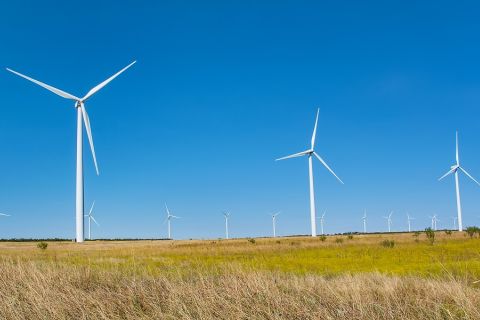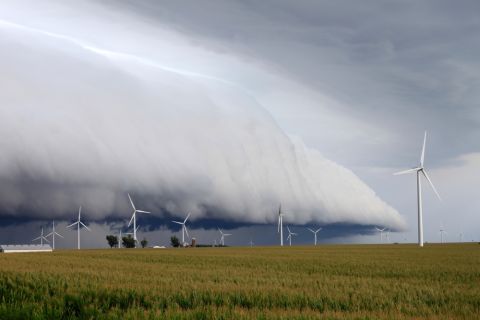This story will appear in the upcoming Hydraulic Fracturing special report presented by:
Geopolitical mechanizations, domestic supply disruptions and the energy transition are coalescing into a tight market that stands to maintain high commodity prices.
Between July 2021 and June 2022, the average monthly spot natural gas price at the Henry Hub benchmark more than doubled, rising by $3.86/MMBtu from $3.84/MMBtu in July 2021 to $7.7/MMBtu in June 2022, according to the U.S. Energy Information Administration (EIA).
Low inventories have remained below average levels as demand growth generally has outpaced domestic production growth. Indeed, the average inflation-adjusted monthly Henry Hub spot price reached a 12-month high of $8.17/MMBtu in May 2022—the highest price since November 2008, the EIA reported in July.
A cursory look at mid-2022 inventory doesn’t explain the high spot and prompt-month pricing, said Barclays analyst Amarpreet Singh. Rather, it is the underlying supply-demand dynamics driving the unusual price points.
For example, the EIA’s working storage total of 1.9 Tcf is almost 16% below the five-year average of 2.2 Tcf but still above the 2018 average. All told, the cumulative change in working inventory is trailing the previous 10-year average by 240 Bcf year-to-date.
US Natural Gas Supply and Consumption, 2017-2022 (Bcf) |
||
| Marketed Production | Consumption | |
| 2017 Total | 29,238 | 27,140 |
| 2018 Total | 33,009 | 30,139 |
| 2019 Total | 36,447 | 31,132 |
| 2020 Total | 40,614 | 30,472 |
| 2021 Total | 41,183 | 30,283 |
| 2022 4-month YTD* | 13,949 | 11,745 |
| 2021 4-month YTD | 13,321 | 11,188 |
| 2020 4-month YTD | 13,917 | 11,289 |
“Two key trends to highlight are a) a slowdown in domestic supply growth due to capital discipline and plateauing unit productivity in key tight oil and gas regions and higher net exports due to the ramp up in LNG shipments; and b) significantly reduced elasticity of demand from the power generation sector due to capacity reductions and tight coal markets,” Singh said.
The EIA forecasts production this year will gain 2.6 Bcf/d from 2021. However, this still implies that net supply at year-end would be below the 2019 level, and that tightness would remain in the market.
RELATED:
Why Putin Brought a Gas Pipeline to a Knife Fight
Takeaway constraints
Singh said it is likely that takeaway capacity constraints in the Permian Basin could bottleneck supply additions this fall; brownfield capacity additions for three of the existing pipelines in the region—Permian Highway, Gulf Coast Express and Whistler—are in the works but will not come online until the end of 2023.
Meanwhile, production growth in the largest producing region, Appalachia, is constrained by limited pipeline capacity out of the Marcellus Shale. Analysts say that market tightness is unlikely to quickly abate, keeping prices higher long term.
Credit Suisse is projecting that the gas market will likely remain tight through at least 2025.
“A major contributor to the current disruption and tightness of global gas markets is Europe’s surging demand for liquified natural gas in order to replace Russian pipeline gas,” the investment bank said.
All of which will “support prices amid slower supply growth over the coming months, in our view,” Barclays’ Singh said.
But meanwhile, U.S. extraction innovation continues to raise domestic natural gas production to new heights. Since 2001, supply has grown 80%. Between 2005—when production snagged at 18,927,095 Mcf—and the 2021 figure of 37,011,455 Mcf, growth reflects a staggering 96%.
The EIA is targeting U.S. production of dry natural gas to increase again this year—but not as much as demand. The agency in June estimated natural gas production in 2022 to average 96.5 Bcf/d, a 3% increase from 2021.
Selected US Average Natural Gas Prices, 2017-2022 ($/Mcf) |
||||
| NGPL Composite Spot Price / Mont Belvieu | Henry Hub Spot Price | Citygate Price | Electric Power Price | |
| 2017 Annual Average | $6.92 | $2.99 | $4.16 | $3.51 |
| 2018 Annual Average | $8.20 | $3.15 | $4.23 | $3.68 |
| 2019 Annual Average | $5.49 | $2.56 | $3.81 | $2.99 |
| 2020 Annual Average | $4.47 | $2.03 | $3.43 | $2.48 |
| 2021 Annual Average | $9.02 | $3.89 | $6.11 | $5.16 |
| 2022 4-month YTD* | $11.72 | $5.14 | $5.66 | $6.05 |
| 2021 4-month YTD | $7.34 | $3.29 | $6.48 | $6.52 |
| 2020 4-month YTD | $3.79 | $1.86 | $3.17 | $2.43 |
IEA out of step
Despite its previous rhetoric detailing the countries mired in energy poverty that desperately need natural gas as a bridge fuel to a greener economy, the Paris-based International Energy Agency (IEA) is a consistent contrarian that routinely drags down demand figures.
The agency said in 2020, global demand shrank 1.2% and fell to 3,970 Bcm—below the floor estimated in 2019 at 4 Tcm.
And while IEA had previously forecasted demand growth, the agency in July did an abrupt about face with its “Gas Market Report.” This summer, its crystal ball showed a total rise of 140 Bcm in global gas demand between 2021 and 2025—less than half its earlier estimate and a reduction from the 170 Bcm increase last year.
This contraction is a result of Russia’s war in Ukraine, supply disruptions and the incumbent high prices as the leading the downward revision, according to the IEA.
Annual US Natural Production by Select Regions, 2017-2021 (Volume in MMcf) |
|||||
| 2017 | 2018 | 2019 | 2020 | 2021 | |
| Colorado | 1,706,364 | 1,847,402 | 1,986,916 | 1,990,462 | 1,876,335 |
| Gulf of Mexico | 1,060,452 | 974,863 | 1,015,343 | 789,262 | 769,870 |
| Louisiana | 2,139,830 | 2,832,404 | 3,212,318 | 3,206,163 | 3,383,977 |
| New Mexico | 1,299,732 | 1,493,082 | 1,769,086 | 1,948,168 | 2,327,871 |
| North Dakota | 593,998 | 706,552 | 850,826 | 882,443 | 945,452 |
| Ohio | 1,791,359 | 2,403,382 | 2,651,631 | 2,378,902 | 2,266,636 |
| Oklahoma | 2,513,897 | 2,875,787 | 3,036,052 | 2,786,366 | 2,571,834 |
| Pennsylvania | 5,453,638 | 6,24,832 | 6,896,792 | 7,148,295 | 7,692,658 |
| Texas | 7,223,841 | 8,041,010 | 9,378,489 | 9,336,110 | 9,416,660 |
| West Virginia | 1,514,278 | 1,771,698 | 2,155,214 | 2,592,319 | 2,760,429 |
| Wyoming | 1,590,059 | 1,637,517 | 1,488,854 | 1,306,368 | 1,237,709 |
| U.S. Total | 29,237, 825 | 33,008,867 | 36,446,918 | 36,202,446 | 37,011,455 |
“The turmoil is damaging natural gas’ reputation as a reliable and affordable energy source, casting doubts about the role it was expected to play in helping developing economies meet rising energy demand and transition away from more carbon-intensive fuels,” the agency said in a statement.
The IEA’s assessment is not a common one.
Indeed, the agency’s position is simply wrong, said energy business advisor Dallas Salazar, CEO of Atlas Consulting Ventures.
“That prognostication is just a joke,” he told Hart Energy. “I don’t have any rational explanation for why they continue to beat that drum.”
Takeaway infrastructure is lacking in some of the U.S.’s gassier plays like the Marcellus and the Utica, but the Haynesville has ample capacity for growth, Salazar said.
“The only cap on natural gas demand is the supply,” he said. “And that supply is currently capped mostly by the U.S. and how quickly can we build export facilities, which are incredibly complex and expensive infrastructure developments.”
But demand is only heightened by the world’s current events. And many parts of the world are building import facilities to transition to natural gas from coal, so the market’s tightness will concentrate, Salazar said.
“There is something to be said about the old Aubrey McLendon phrase [advising] to build the supply economy before you build the demand economy,” Salazar said. “This is the vision of McClendon coming through natural gas. It is the bridge fuel.”
Recommended Reading
Scout Signs Agreement with AdventHealth for Texas Wind Farm
2024-02-01 - Scout Clean Energy will supply a portion of its Heart of Texas wind farm to support 40% of AdventHealth’s electricity needs.
Avangrid Begins Construction on its First California Solar Farm
2024-04-10 - Avangrid’s Camino Solar project will generate 57 megawatts of power, the equivalent of the power needs of about 14,000 U.S. homes.
Avangrid to Build its Fifth Wind Farm in Illinois
2024-03-12 - Osagrove Flats, the 153 MW wind farm, will bring Avangrid’s renewable energy capacity in Illinois to nearly 800 MW.
Clean Energy Begins Operations at South Dakota RNG Facility
2024-04-23 - Clean Energy Fuels’ $26 million South Dakota RNG facility will supply fuel to commercial users such as UPS and Amazon.
First US Utility-scale Offshore Wind Farm Starts Operations
2024-03-14 - The 12-turbine, 130-megawatt South Fork Wind project is a joint venture between Denmark's Orsted and New England-based electric utility Eversource.





